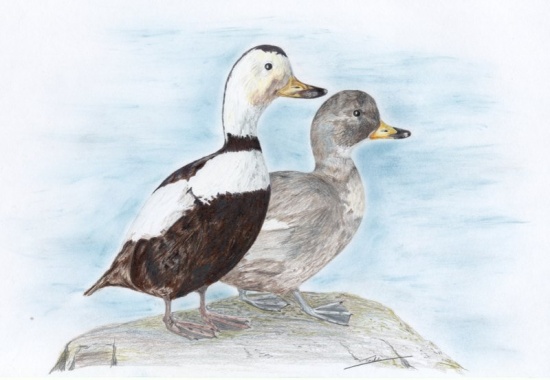
|
The species Labrador Duck is extinct. |

|

- Camptorhynchus labradorius
Identification
The male was black and white (giving rise to vernacular names such as 'Pied Duck' or 'Skunk Duck') with black on the outer wings, back, underparts and a line of black up the back of the neck and head. The bill was yellow and black. The bill also had an unusual shape, with flexible edges.
The female was grey-brown with a paler throat and white inner wings.[1]
Distribution
The winter quarters extended from the south-eatern shores of Canada through coastal New England, with many around Long Island.[2] The breeding range was not well identified, although some placed it as breeding around Labrador. Dutcher[3] reported that they were mostly seen in this area in the autumn on migration south, indicating that breeding occurred further north. This species declined quickly with the last supposed sighting being at Elmira in New York in 1878 when a single bird was seen (the last confirmed bird was shot at Long Island three years previously).[2] The reasons for their decline are unclear, although hunting and habitat loss have been implicated.[4]
Taxonomy
The Labrador Duck was monotypic [7] and its closest relatives are the scoters of the genus melanitta.[5]
Habitat
In winter, they were found on coastlines and islands. Severe weather would force them to venture up rivers inland.[1] Breeding habitat is unknown.
Behaviour
Little has been recorded about this species - almost nothing is known about its nesting and breeding behaviour. It was known to be migratory, but became extinct before many realised it was in severe decline. Audubon reported that it fed on "small shell-fish, fry, and various kinds of sea-weeds."[1] As such, industrialisation of the Eastern Seaboard of the US and Canada may have robbed the species of its winter feeding grounds. Additionally, the species was never particularly common. The bill of the Labrador Duck had a set of flexible lamellae, which made it a specialist filter feeder - as such it is highly possible that the specialist feeding (and probably therefore diet), coupled with hunting and predation by introduced species all contributed to its decline.[2,4,6]
References
- "Pied Duck", Audubon Society. http://web4.audubon.org/bird/BoA/F39_G5f.html
- Labrador Duck: the Mystery Extinction, Cornell lab of ornithology. http://www.birds.cornell.edu/AllAboutBirds/conservation/extinctions/labrador_duck
- W. Dutcher, The Auk, 1894, 11, 4-12. http://elibrary.unm.edu/sora/Auk/v011n01/p0004-p0012.pdf
- Birdlife International. http://www.birdlife.org/datazone/speciesfactsheet.php?id=488
- B. C. Livezey, The Condor, 1995, 97, 233-255. http://elibrary.unm.edu/sora/Condor/files/issues/v097n01/p0233-p0255.pdf
- P. Johnsgard, Handbook of Waterfowl Behaviour: Tribe Mergini (Sea Ducks), Cornell University Press, 1965. http://digitalcommons.unl.edu/cgi/viewcontent.cgi?article=1017&context=bioscihandwaterfowl
- Clements, JF. 2010. The Clements Checklist of Birds of the World. 6th ed., with updates to December 2010. Ithaca: Cornell Univ. Press. ISBN 978-0801445019. Spreadsheet available at http://www.birds.cornell.edu/clementschecklist/Clements%206.5.xls/view
Recommended Citation
- BirdForum Opus contributors. (2025) Labrador Duck. In: BirdForum, the forum for wild birds and birding. Retrieved 28 April 2025 from https://www.birdforum.net/opus/Labrador_Duck




